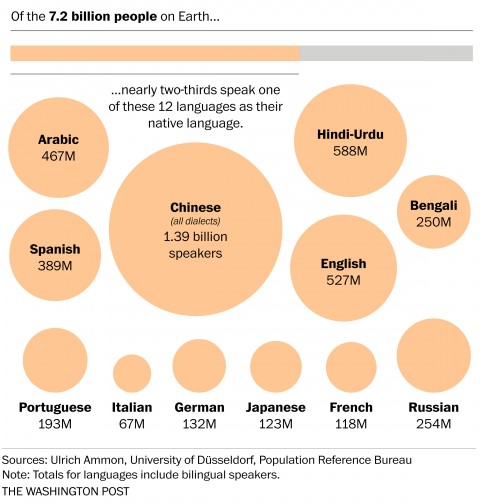What language is most widely spoken in the world? That depends on how you define “language” and who you count.
The infographic below is from Rick Noack’s 2015 Washington Post article “The Future of Language” based on data from a 15-year-long study conducted by German linguist Ulrich Ammon. Only native speakers (both bilingual and monolingual) are counted, and all Chinese dialects - e.g. Hakka, Wú, Pǔtōnghuà (Mandarin), Yuè (Cantonese) - are counted together.

But should all Chinese dialects be counted together? The dialect most people think of when they think of Chinese is Pǔtōnghuà or Mandarin, as we tend to call it, but that is only one variety which happens to also be the official language of the Chinese government, and hence widely spoken by speakers of other dialects such as Hakka and Wú. The major varieties are not generally not mutually intelligible and so, some would argue, should be treated as different languages, like Spanish and Italian are. In fact, it doesn’t matter how you cut up the pie, China still has the biggest slice. According to Ethnologue, there are 897 million native speakers of Mandarin (out of 1.3 billion speakers of all Chinese dialects) which is still far more than the runner up, Hindi-Urdu at 588 million according to Ammon.
What if you count more than native speakers? That changes a lot, as you can see in the infographic from Joe Myers’ World Economic Forum’s blog below. Then, English takes the lead.

But what about the most widespread language, i.e. not the language with the most speakers, but the language that is spoken in the largest number of countries in the world? According to the Noack’s Washington Post article, Arabic, French and Spanish get a bump.

And what about the most important languages for doing business? According to a study titled Languages for the Future, created by the British Council, here are some of the fastest-growing markets and their languages:
| Country | Language |
| Argentina | Spanish |
| Bangladesh | Bengali |
| Brazil | Portuguese |
| Chile | Spanish |
| China | Mandarin and other Chinese languages |
| Colombia | Spanish |
| Czech Republic | Czech |
| Egypt | Arabic |
| Ghana | English, plus Akan and others |
| India | English, Hindi, Gujarati, Panjabi, Urdu, Bengali and others |
| Indonesia | Indonesian, Javanese and others |
| Iran | Farsi Kazakhstan Kazakh |
| Malaysia | Malaysian |
| Mexico | Spanish |
| Nigeria | English, plus Hausa, Igbo, Yoruba and others |
| Pakistan | Urdu |
| Philippines | Tagalog |
| Poland | Polish |
| Russia | Russian |
| Saudi Arabia | Arabic |
| South Africa | English, Afrikaans, Xhosa, Zulu and others |
| South Korea | Korean |
| Taiwan | Mandarin Chinese |
| Thailand | Thai |
| Turkey | Turkish |
| United Arab | Emirates Arabic |
| Ukraine | Ukrainian |
| Vietnam | Vietnamese |
From this perspective, important languages for business include Spanish, Arabic, Hindi, Tagalog, Russian, Korean, Thai and Vietnamese.